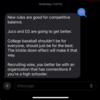I think this is a good thing.
Some here might have sons involved in programs that do the right thing. It should force coaches not to over recruit.
It takes a lot of planning (adding and subtracting) and it's hard work between spring and fall exit interviews, adding and/or losing players in the portal, losing or not losing players in the draft.
As far as I am aware, redshirt players do count on a D1 roster. If there are 34, 35 allowed on a roster, that is your roster regardless of redshirt vs non redshirt players, athletic vs academic.
Aren't academic players essentially walk ons?
Therefore, recruiting will change. How? I don't know the details as of yet. A coach that I know has been on the road all summer watching juniors. Also watching those that will sign their NLI in November. If programs have a solid and successful program (D1, 2 or 3), no sweat.
Remember, these new rules don't happen for another year.
We need to stop speculating and sit back and let it play out.
As far as I am aware, the official roster is the one submitted before the first official game.
JMO

